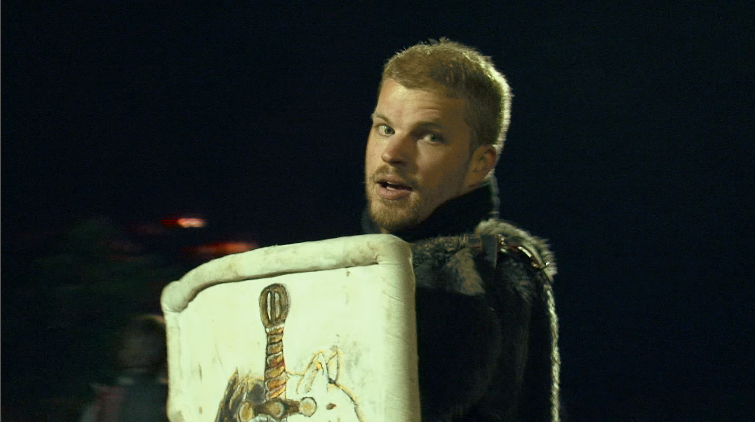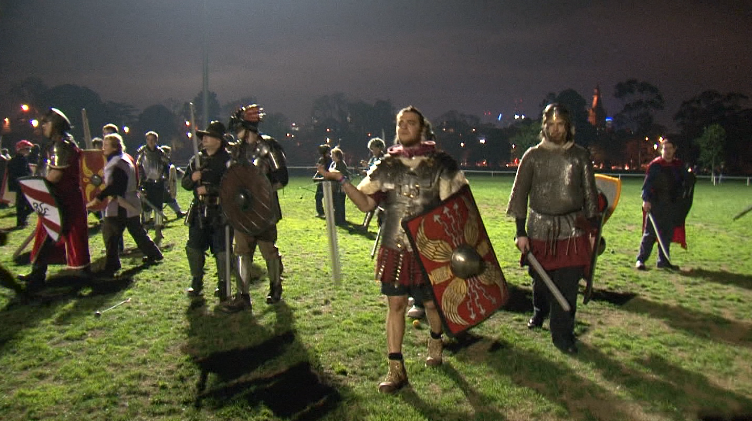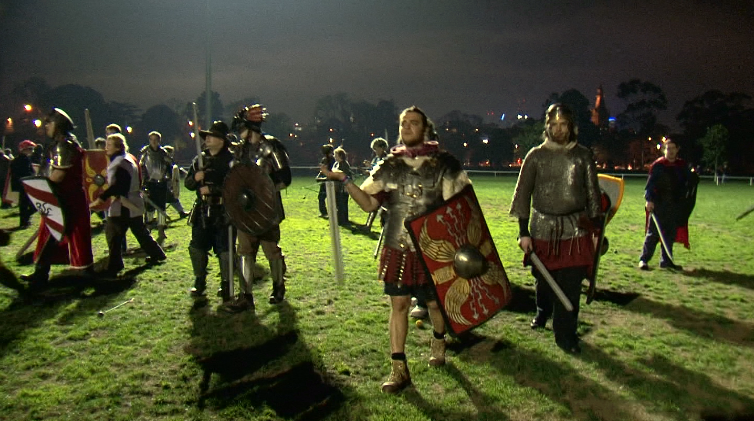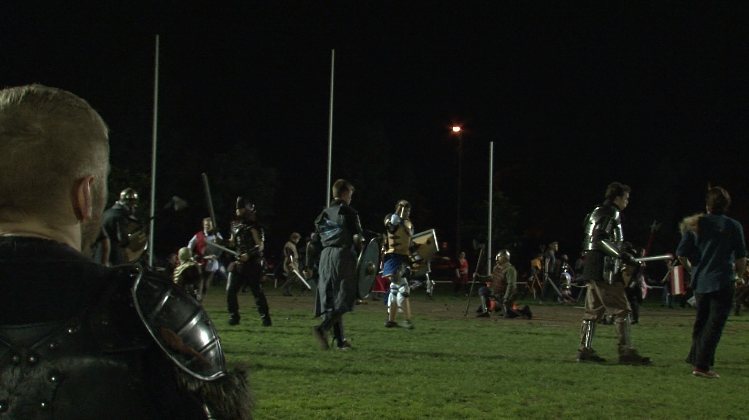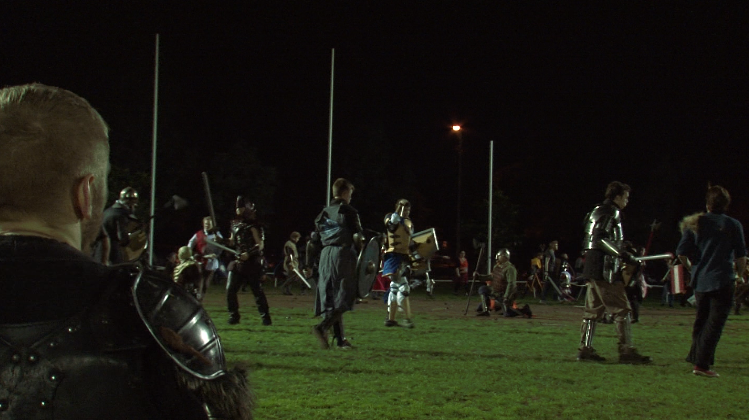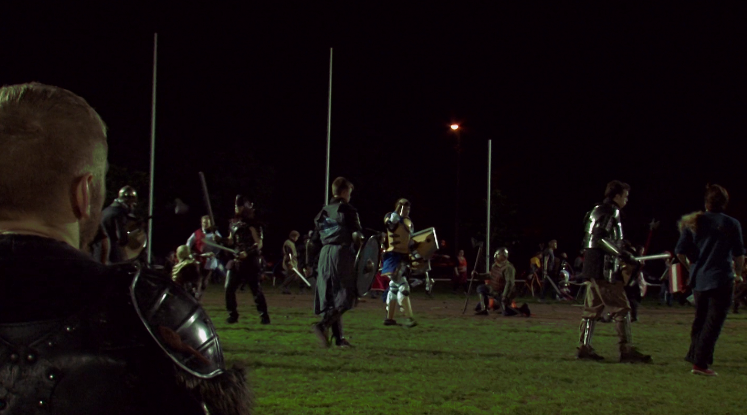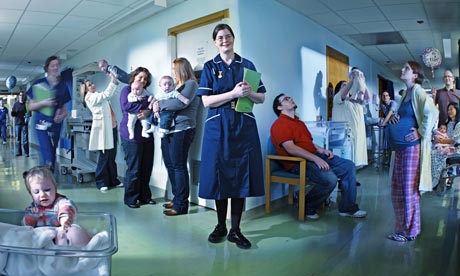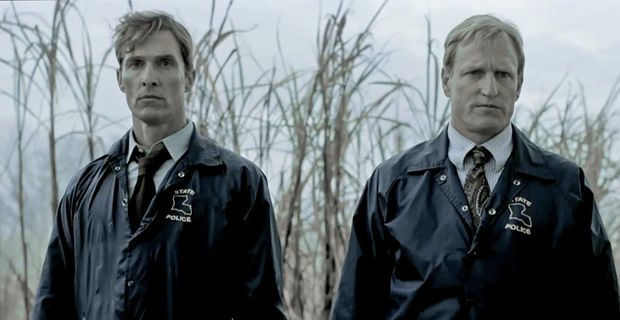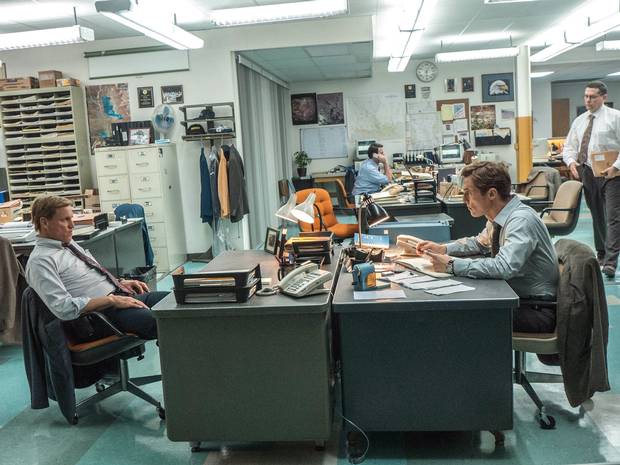VLOG from Tiffany Potashnyk on Vimeo.
Author Archives: tiffanypotashnyk
Assessment 1: Ugh! As if you used Pop Culture to make Pop Culture
On March 4th, 2014 Iggy Azalea released her music video for the song ‘Fancy’ (Director X, 2014) inspired by the 1995 American film Clueless (Amy Heckerling, 1995). The trailer depicts Azalea as Cher Horowitz (Alicia Silverstone), a Beverly Hills socialite, and features artist Charli XCX as her friend Tai Frasier (Brittany Murphy). After the release, the song went on to become Billboard’s ‘Song of Summer’ 2014 and the video has been viewed over 500 million times on YouTube. The re-enactment of Clueless within the video helps to promote the song into popular culture and forge the identity of Azalea.
Clueless has become a, “90’s cult classic” (Madden, S; 2014), therefore by choosing to re-create scenes from the film the song taps into an already established fandom that has made the film a part of their discourse. The recreation of key moments displays how culture is a, “process we participate in” (Takacs, S; 2015, p.3), as it rewards those who are able to make the connection to Clueless while educates those who don’t know its relevance. The clip uses nostalgia to gain interest and takes advantage of this vulnerability to fulfil it’s, “commercial agenda,” (Railton, D & Watson, P; 2011, p.2) for example, the electronic closet at the beginning of the video has ‘REVOLVE’ sprawled across the screen, the same name and font of an actual online store.
In the video Azalea uses the iconic character of Cher as a platform to build her own identity. Diane Railton and Paul Watson argue that our identity, “…is a product of our specific social, cultural and historical situation” (Railton, D & Watson, P; 2011, p.20); therefore by acting as Cher, Azalea situates the audience’s understanding of the character to develop herself. Through, “subtle changes,” such as the attitude she exudes in her body language when she struts down the corridor and the, “confiden[ce] and sex appeal,” she elicits when stretching at the tennis court, she establishes her existence as a rap music artist (Lyne, C; 2014). Therefore, this re-enactment is not just a, “wholehearted love letter to a titan of pop culture,” (Lyne, C; 2014) but a ploy that uses Clueless to gain worth and propel the product and artist into current popular culture.
References
Lyne, C 2014. ‘Clueless: the classic teen movie that continues to inspire,’ The Guardian (Film Section): http://www.theguardian.com/film/2014/mar/07/clueless-classic-teen-movie-iggy-azalea, March 2015.
Madden, S. ‘Iggy Azalea’s ‘Fancy’ Video Is Basically An Exact Replica of ‘Clueless’,’ MTV, 2014: http://www.mtv.com/news/1723476/iggy-azalea-fancy-charlie-xcx-clueless/, March 2015.
Railton, D & Watson, P 2011. ‘Music Video and the Politics of Representation,’ Edinburgh University Press, Edinburgh, pp.1-40.
Takacs, S 2015. ‘What is Popular Culture?’ (Chapter One), Interrogating Popular Culture: Key Questions, Routledge, New York, pp.1-17.
Popular Culture Example 3: “It’s like when I had this garden part for my father’s birthday”
Cher Horowitz (Alicia Silverstone) is a Beverly Hills socialite who’s attractive, popular and wealthy – her character from the “90’s cult classic” (Madden, S; 2014), Clueless (Amy Heckerling, 1995) has become a symbol of popular culture after, “searing itself into the hearts, minds and elaborate vocabularies of a generation” (Lyne, C; 2014). Inspired by the American film Iggy Azalea released her music video for the song ‘Fancy’ (Director X, 2014) on March 4th, 2014 with the trailer depicting Azalea as Cher and featuring artist Charli XCX as her friend Tai Frasier (Brittany Murphy). After the release, the song went on to become Billboard’s ‘Song of Summer’ 2014 and the video has been viewed over 500 million times on YouTube.
The ‘Fancy’ music video employs Clueless to make the product more appealing to viewers and create a platform for Azalea build her identity as an artist. Diane Railton and Paul Watson argue that, “our identity is not something that comes from within… it is a product of our specific social, cultural and historical situation” (Railton, D & Watson, P; 2011, p.20). Consequently, by paying homage to the film in her music video Azalea identifies herself as a follower of popular culture like the audience. And through acting as Cher, she identifies with the character traits to build the identity of a relatively unknown artist. Similarities to character are created through the use of iconic clothing, such the yellow plaid ensemble, and recreation of key scenes from film, like the highway driving lesson.
However, an identity can also relate to a person’s differences, which the video uses to separate Azalea from the character and forge her existence as a rap music artist. This can be seen in “subtle changes,” such as the attitude she exudes in her body language when she struts down the corridor and the, “confiden[ce] and sex appeal,” she elicits when stretching at the tennis court and in the tighter and more revealing clothes than the original character depicted (Madden, S; 2014). Therefore, this re-enactment is not just a, “wholehearted love letter to a titan of pop culture,” (Lyne, C; 2014) but a ploy that uses nostalgia to gain interest and takes advantage of this vulnerability to fulfil it’s, “commercial agenda” (Railton, D & Watson, P; 2011, p.2).
References
Lyne, C 2014. ‘Clueless: the classic teen movie that continues to inspire,’ The Guardian (Film Section): http://www.theguardian.com/film/2014/mar/07/clueless-classic-teen-movie-iggy-azalea, March 2015.
Madden, S 2014. ‘Iggy Azalea’s ‘Fancy’ Video Is Basically An Exact Replica of ‘Clueless’,’ MTV: http://www.mtv.com/news/1723476/iggy-azalea-fancy-charlie-xcx-clueless/, March 2015.
Railton, D & Watson, P 2011. ‘Music Video and the Politics of Representation,’ Edinburgh University Press, Edinburgh, pp.1-40.
Popular Culture Example 2: When McDonald’s and SpongeBob invade the catwalk
Fashion designer Jeremy Scott’s takeover of the Italian luxury fashion house Moschino in October 2013 as creative director saw the brand morph into a company inspired and well aware of popular culture. The Fall/Winter 2014/15 show used pop culture and fast food as inspiration, with tribute to, “everyone’s favourite all-American guilty pleasure,” McDonald’s, Budweiser, truck-stop snacks and SpongeBob Square Pants (Hyland, V; 2014). The capsule collection was made available immediately online and sold out within 24 hours, prompting a form of fast fashion where aside from celebrity praise in the form of Miley Cyrus, Rihanna and Katy Perry, the popularity of the collection can be linked to the iconic subjects it uses.
Fashion has the ability to turn, “…the body into a discourse, a sign, a thing,” allowing ourselves to be exposed, “to grotesque openings toward the world,” (Hancock, Joseph H, Johnson-Woods, T & Karaminas, V, 2013; p.xii) where the influence can be bought and worn. The saleability of the Moschino collection is somewhat self-generated by the convergence between two areas of popular culture: fashion and subject matter. This merging on one level displays popular culture through fashion, but on another it articulates an understanding of popular culture that is extended to the consumer who buys the product.
Fiske notes, “the mundane is the crucial site of cultural significance, for the mundane is the only terrain upon which popular culture can be made to matter” (Fiske, J; 1995, pp.330). The collection’s use of popular codes that have become ordinary within society, such as the McDonald’s ‘M’, re-purposes their existence in culture prompting an appreciation for them and in turn a deeper connection to the consumer. Each piece also encodes, “social meanings about gender, sexuality and identity,” (Hancock, Joseph H, Johnson-Woods, T & Karaminas, V, 2013; p.xi), in the manner they were designed. The Hershey’s dress, flows like melted chocolate but also embodies the idea of treating yourself as you would on a ball or night out and the McDonald’s bag is an everyday accessory for the everyday kind of food that comes in a bag. These items encode cultural meaning so they can, “serve the interests of the people” (Fiske, J; 1995, pp.322).
References
Fiske, J. ‘Popular Culture,’ in Lentrichchia, F & McLaughlin, T 1995. Critical Terms for Literary Study, The University of Chicago Press, Chicago, pp.321-335.
Hancock, Joseph H, Johnson-Woods, T & Karaminas, V 2013. ‘Introduction’ in Fashion in Popular Culture: Literature, Media and Contemporary Studies, Intellect, UK, pp. xi-xvi.
Hyland, V 2014. ‘At Moschino, Jeremy Scott turns Pop Culture Trash into Sold-Out-In-Minutes Treasure,’ Elle Magazine: http://www.elle.com/fashion/a14689/jeremy-scott-for-moschino-profile/, March 2015.
Popular Culture Example 1: Put some Coconut Oil on it!
Stacy Takacs notes that culture is the, “active process of generating and circulating meanings and pleasures within a social system” (Takacs, S. 2015, p.3), with the strand of Popular Culture identifying the, “ways that mass cultural texts, objects, and performances are created, circulated, and received by individuals in their everyday lives” (Takacs, S. 2015, p.8).
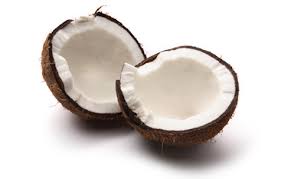
Having visited a health food store recently it was startling to see how many products made of coconut were available, the most prominent being the several choices of coconut oil. Coconut oil has turned into a health food trend with endorsements from nutritionists claiming it plays a positive role in preventing disease (Jacob, A. 2013), to celebrities like Gwyneth Paltrow who gargles it in her mouth for fresh breathe and Channing Tatum rubbing it all over his wife’s pregnant stomach (Hou, K. 2014). These, “popular… people and their practices of creation, interpretation, and agency,” (Takacs, S. 2015, p.8) appropriate the commodities usefulness within society. Thus by sharing what they use the oil for they provide a, “culture… embodie[d]… in the things people do with the commodity,” and, “excorporate,” the artefact within society to make it popular (Takacs, S. 2015, p.6).
The concept of using coconut oil for wellbeing is not new within certain cultures as it’s been a, “staple in tropical regions of the world for thousands of years” (Jacob, A. 2013). What’s surprising is how it’s recent accent into popular culture through celebrity and health outlets has led to a response in the market to introduce more products, therefore, “transform[ing]… cultural traditions into commodities that can be bought and sold” (Takacs, S. 2015, p.2). The products health benefits also has the ability to overshadow its material value allowing consumers to get disillusioned in the craze and forget the intention for, “mass-production [of] commercial profit by centralized cultural industries” (Takacs, S. 2015, p.4-5).
References
Hou, K 2014. ‘25 Weird Things Celebrities Have Done With Coconut Oil,’ The Cut – New York Magazine: http://nymag.com/thecut/2014/10/25-things-celebrities-have-done-with-coconut-oil.html, March 2015.
Jacob, A 2013. ‘Coconut Oil – Learn More About This Superfood That Contains Healthful Saturated Fats,’ Today’s Dietitian, vol.15, no.10, p.56: http://www.todaysdietitian.com/newarchives/100713p56.shtml, March 2015.
Takacs, S 2015. ‘What is Popular Culture?’ (Chapter One), Interrogating Popular Culture: Key Questions, Routledge, New York, pp.1-17.
Film-TV2- Documentary Reviews
Sneakerhead Collective
It was a clever choice to structure the piece to take a comparative approach between Jordan sneaker collectors and luxury sneaker collectors, through this the documentary acted to contrast these types of collectors and then merge them together through their passion. The documentary had some really interesting shots, such as the stop motion of the shoes placed all over the tech guy that conveyed interest through the innovation of depicting the subject. Towards the end of the piece the ideal of money and how much all these shoes cost comes into question, the numbers illustrated on screen with each digit coming up to equal the amount of money these collectors spent together, was a smart way of expressing the attachment and investment of these shoes. The choice of having an American narrator makes what’s being said more familiar because we’re accustomed to it through such things as film, and somehow makes the piece have an entertainment value. The use of locations such as, the graffiti laneway, shoe shops and the Sneaker Freaker swap-meat, display the sense of place these shoes are connected to and the events that take place around them. It was also really interesting how the interviewees spoke about the design behind some of the shoes, like the Buscemi shoes designed after the Hermès’ Birkin bag and the Nike Bacons after a butcher, in doing this the film conveys to the audience how as Christian Louboutin once said, “a shoe has so much more to offer than just to walk.”
Waves
Really well executed documentary that achieved its aesthetic through the variety of scenes to display the subject of water and flowing music to eliciting the ideal that surrounds surfing. Visually the piece is wonderful, the underwater shots paired with the echoing audio you hear when you’re beneath water, it wasn’t the typical sound of splashing water but a more ominous sound you hear personally. There’s one shot where there’s a full circle camera track around of the surfer as he stands on the beach, demonstrating the subject’s insignificance to the water paired with his need to have this place. The piece is driven on the relationship between this surfer and the waves, we always see him with them and somehow we understand he needs them more than they need him. The images make you feel a part of the ocean and surf, and you realise why the participant does this. With the slow motion of waves rolling by as he stands there time seems still, slowly capturing the euphoria of being in a world where nothing matters more than catching the next wave before it passes by.
Black Cat
A documentary is well executed when it allows the viewer to question themselves, and this is exactly what I did after watching Black Cat. I’m not overly superstitious but some things you just don’t do because of reoccurring sayings around them, and the documentary helped to illustrate the extent to which these superstitions can govern your life. The opening credits were really well done, the muttering of quotes accompanied by on screen text foreshadowing the superstitions covered in the documentary, and then the cat walking up which is frozen upon when the main title appears. It was really well polished and created the necessary supernatural hint to begin the piece. The use of archive footage was really well done, such as the scenes of the Grand Final and audio of commentators, furthering this supernatural effect that is based around superstition. The variety of participants helping to broaden the understanding of all the different people that experience superstition, acting to display all these for the audience so that they can begin to question their own beliefs.
Theanna
I loved that the whole documentary was in Greek and you used subtitles to translate it for the audience, it made us understand your grandma’s story through the language barrier. This also permitted more concentration from the viewer as you have to read as well as watch allowing more of a chance to get submerged in what’s going on. Therefore, we see and understand her hardship of losing her husband, but also the joy that he allowed to be passed onto the generations. I think how you displayed the journey of being told these stories, showing the moments where you open the dusty trunk housing all the letters and opening the unopened card, and then choosing to appropriate this structure to cooking was smart. The fact that she found an unopened letter and read it to us was poignant as her emotion was so raw and there’s nothing more compelling than documenting that for the audience to experience on screen. I also found the crunching as she cuts up the pastry with scissors a great sound motif, with food being something that represents heritage and brings together family. The technique of allowing the last words on screen to stay until the black screen and then fade off made the last sentence resonate nicely; it was a perfect ending to a love story that wouldn’t happen the same way today.
Cactus
Cactus is a prime example of how sometimes just having an excellent subject can make the documentary. The man reminded me of one of the first Film-TV2 lectures when we were shown a clip from an Errol Morris’ documentary of a man with turtles, I didn’t really know why he was showing us the turtles but everything he had to say about them was so compelling when place on screen. Cactus shows the world of the subject, placing us in his planting yard and at his cactus events, allowing us to see his passion for cacti through each little pot he plants. That opening shot where he stands with the magnifying glasses picking at the cactus stem was brilliant, almost like he was performing an operation on the plant. He has such great dialogue, such as when he talks about illegal importing the cacti through customs, which makes it easy to listen to anything he says. The only criticism, is perhaps the garden background noises is a little loud when he’s sitting at the table as it’s hard to hear what he’s saying, but honestly I overlooked this when I saw the magnificent pompom hat.
Forbidden Xanadu
It’s arguable to say that without an audience there isn’t art, as sometimes it’s the undiscovered art that can create the audience. Forbidden Xanadu acts to contrast the busy graffiti laneways of Melbourne to the deserted train yard of the outer city suburbs, that at the beginning of the piece you wouldn’t expect it to do. Through this the documentary contextualises the art of graffiti without an audience, something that’s so much more beautiful than the popular wall murals of the city streets. The audience is shown graffiti culture through the images with the aid of narration, viewing the polished world of graffiti we see every day in our streets and the one where people live through giving life to things left behind. The beginning of the documentary depicts Melbourne’s street acceptance of graffiti in designated laneways, for example there’s a man with spray paint cans out in broad daylight as people walk past, these shots being quite cool in colour. This coolness is then contrasted in the railway yard, with shots like the heat rising from the railway tracks and the rust of the carriages. The audio throughout the documentary makes the piece more self-reflexive as it documents the filmmakers experience with seeing the deserted train yard, we are there as he climbs up the ladder to the top of carriage and looks down on this world, making us appreciate this as a form of undiscovered art.
Film-TV2- Analysis/Reflection 5 – Question 2
“In 200 words or less please outline you goals, desires – what you want to get out of this semester. You will review this later in the course. You may rethink this dramatically – this is a good thing.”
You were asked this at the beginning of the semester. Now, could you review constructively what you got from this semester – has the course lived up to your expectations, delivered what you expected, maybe even surpassed it?
The beginning of Semester Film/TV2 Anticipations
Though our documentary still isn’t finished and we spend these last few days fine tuning different aspects, I can definitely say I’m proud of what we have thus far and hope audiences will enjoy it. It’s so fulfilling to see after filming all those Friday nights we have something that not only demonstrates what Larping is about but that explores documentary practice in the depiction of the spectacle. Those nights we would go down and just start filming, action, people, interaction, asking questions and really engaging with the community that exists behind the subjects, allowed us to experience the exploration and interactions that documentary filmmaking is all about. Some of the best moments being on field with a person on camera, someone else on the mixer and a third person to tell the other two when people to move away from the battle that was heading straight towards them.
Furthermore, I believe our film is, “refined in technique and construction,” and am happy that we took a collective decision to create something that expressed the form of documentary in a creative way, by getting the participants to speak in character and transporting the viewer into the world these people inhabit every week. Though we had some issues with technique along the way, such as technical problems with the grain of shots and audio pitching, we worked collectively within the group to come to accept these mistakes and learn from them in the following weeks.
I’ve enjoyed the documentary process right from the beginning, this in part can be attributed to the great group we had as we all got along really well and shared an enthusiasm for the project from the first day. It made the processes required not only so much easier but exciting to achieve, and reassuring to know that we had the ability to voice our opinions and concerns freely. Each person brought another element to the production process and we all worked collaboratively taking turns in the construction. We didn’t assign specific roles to members but instead allowed people to have a go at doing different elements and worked individually to do things where we saw necessary. Personally, this included the, “opportunity to deal on the technical side of shooting,” with filming on field and recording audio allowing me the chance to build the technical knowledge needed in documentary production. Looking back at the choice of subject for the documentary, “I hope[d] to choose something interesting and that I may not have much knowledge about,” which I believed was achieved as I had little knowledge about Larping before the idea was brought up in class, I didn’t even know there were battles at Princess Park every Friday night, and the whole production has intrigued me as much as I hope it will intrigue the viewer.
From an analytical side I aspired to develop my ability to, “analyse documentary programs as a practice and how to apply that knowledge to my own work and others,” and believe such things as the lectures have served an inspiration for this practice, with the weeks where we’d filter through fifteen different documentaries and look at the style of interviews or watch a past student’s work really helping to build this understanding. Furthermore, this course has also allowed me to develop a greater appreciation for the documentary process and all that it involves, individually as well as a part of a team, to create something that is distinctly ours.
“And finally to have fun and enjoy the whole process because before you know it twelve weeks are gone,” and sure enough they did pass by fast, but I look back knowing I have enjoyed the whole semester. I’ve learnt key elements of production, forged relationships and an outlook on the making of documentary as a platform for me to learn invaluable skills for the future.
Film-TV2- Analysis/Reflection 5 – Question 1
As per lecture – in a sequence you’ve called ‘colour’ you will have clips that are indicative of a particular colour or lighting state. To the right of that clip you will have the same clip repeated 2 or more times with different colour grades on it.
Take screen grabs of each clip then upload to you blog the series of stills that show us ‘before and afters’ of your colour grading. Provide a few different examples of at least two different clips – each with a description of what you did to the clip and why.
Having to deal with some of our shots coming out grainy due to a filer accidentally being left on during a shoot day, much of the colour grading in the editing stage was to match the aesthetic of footage over the whole documentary. In time we’ve come to accept the graininess of these earlier shots and believe they’ve become a key visual style of our piece, however colour grading will be used to bring the original shots to the best quality and add vibrancy to the colours of the world of Althea.
First Grade
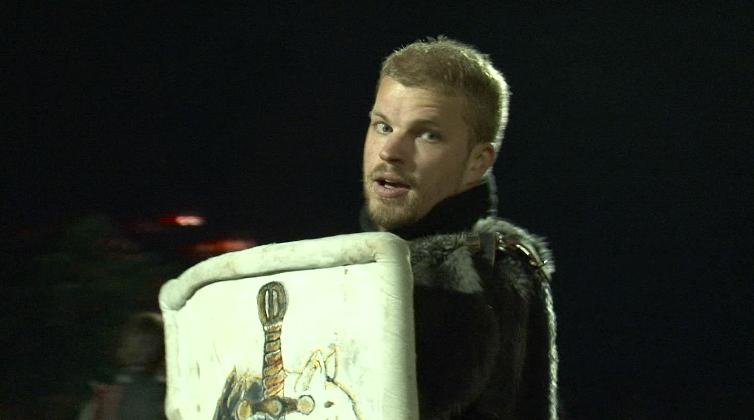 The original shot depicts a soldier with his shield ready for battle
The original shot depicts a soldier with his shield ready for battle
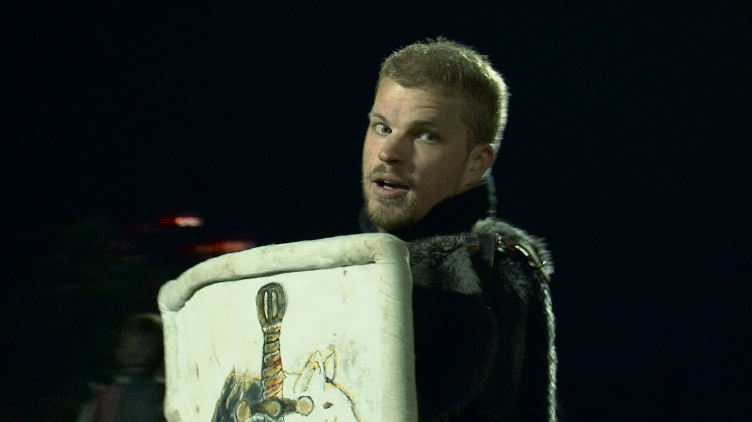 We darkened this second image by making the midtones more blue, emphasising the shadowing across the subject. We also reduced the output levels to reduce the brightness of the shot and made his face more skin like by making the highlights pinker.
We darkened this second image by making the midtones more blue, emphasising the shadowing across the subject. We also reduced the output levels to reduce the brightness of the shot and made his face more skin like by making the highlights pinker.
This third image is a brightened version where we made the midtones warmer bringing them to orange, this gives life to the subjects face and adds a mystical glow around him. We also made the shot a bit darker by lowering the output and making shadows more blue. As orange and blue are complimentary colours they come together to give the finished shot a harmony, making the shot visually pleasing for the viewer.
Second Grade
In the original shot we see a war-band advancing onto the field to fight
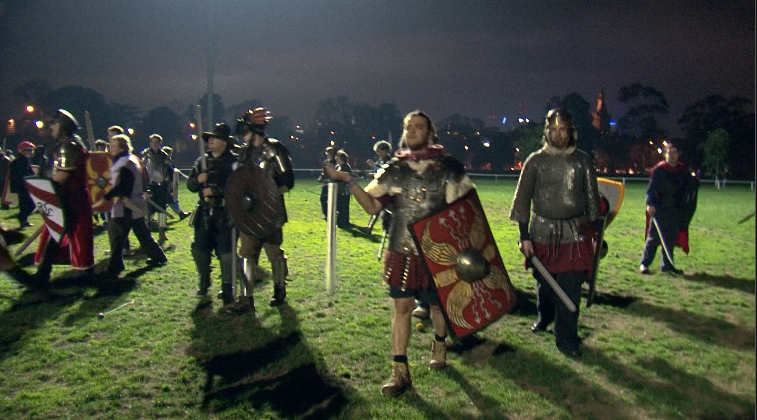 This image was made darker by bringing down the output level and making the highlights greener so that it blends with the subjects better. The shadows are also a darker blue contrasting against the midtones at a light blue, developing the scene to look like a dark night and heightening visual impact for the viewer.
This image was made darker by bringing down the output level and making the highlights greener so that it blends with the subjects better. The shadows are also a darker blue contrasting against the midtones at a light blue, developing the scene to look like a dark night and heightening visual impact for the viewer.
We brightened this shot from the original by raising the input levels to create more shadowing on the field. By making the midtones and highlights more green the grass becomes more vibrant and the reds also appear brighter therefore making the costumes of the participants stand out.
Third Grade
A battler sits and watches the battle waiting to re-spawn
This image appears cooler than the original by making the master a deep red for warmth in the mid-ground and green in the midtones to emphase the grass in the foreground. The highlights are also brighter with a light yellow/pink, giving a soft edge to the outline of the subjects.
By experimenting with brightness and contrast, bringing the brightness to -5.7 and contrast to -0.2 the shot appears sharper than the original. Also made the shadows warmer, midtones greener and highlights pinker to give that underlying warmth to the scene.
The gift of Reality Television
Week Ten – Reality TV – Origins and Contexts
Reality TV is, “a catch-all category,” that includes a range of entertainment programmes about, “real people” (Hill, A; 2005). The idea of the real is paramount to many of the shows considered a part of the genre and, “this access to the real… presented in the name of dramatic uncertainty, voyeurism, and popular pleasure,” (Ouelette, L and Murray, S; 2009) in turn have become a marketing tool for these shows.
The genre, “is located in border territories, between information and entertainment, documentary and drama,” (Hill, A; 2005) with documentary in particular being an important relationship. These types of shows, “associations with documentary… [and] hybridisation of fictional and factual programme styles,” allow its intersection with everyday life and ordinary people (Kavka, M;2012). One Born Every Minute (2010) fits within lifestyle programming, appealing primarily to women and expectant mothers. By analysing the story and production elements of Season One, Episode Four, we can gain a further understanding of why the show can be considered a docu-soap through such things as characters, interviews, narrative, camerawork, and editing.
The show’s subject matter is expecting mothers and their families coming into the hospital’s labour ward, ordinary people as they go through an extraordinary experience. The show is built around these visiting characters, the nurses merely acting as hosts to the show adding there accounts when relevant. The show is structured to make a form of entertainment through the different relationship the viewer has with the families and the nurses. Characters are also used to contrast on each other, for example in this episode we meet Joy, Kelly and their families. Kelly’s family is quite unconventional with their relationship and she’s familiar to the process of childbirth becoming pregnant at seventeen. Tensions are then built by contrasting Joy and Fabio, two immigrants with no extending family and a wealth of money, but their inability to have a child for many years until IVF finally worked underlies how precious this birth is to them.
Consequently the narrative is very character based and the show uses parallel stories, like many other Reality TV shows, to reveal the underlying ideal that the show is fundamentally not around birth at all but more so the relationships that are achieved and tested in the process. For example, the point of connection with the new mid-wife on the ward delivering her first child and Joy giving birth to her first child. There is also a rhythm to the show in relation to drama, as we have spent more time with Joy in her many days on the ward we become anxious for her when she finally goes into the theatre; while we only meet Kelly half way through the episode and her presence doesn’t resonate quite as much.
To further this notion of reality the main interviews don’t appear staged, though there are some moments where there’s an interview of family members, such as Kelly’s sister, that have been staged for either dramatic effect or to further establish the broader family role. Camera style then follows with fixed camera angles, high angles to depict the hospital walls and slow motion shots. This adds a voyeuristic feel to the scenes and makes the viewer feel as though we’re seeing something we shouldn’t be, with everyday CCTV and family home interviews an obvious influences to these shots. The editing of these shots also works to condense time and space so that the piece has rhythm.
Music is used to weave from action to action and to allow emotional connection through events, for example we hear the lullaby-ish music as when Joy goes into the operating theatre to further the emotion the pair feels. Otherwise the lack of music creates pauses between dialogue as you would hear in reality. Dialogue is also used to further establish the characters we are watching, such as Joy’s continued disbelief of “the whole hand” and comments to Fabio on him eating “half a kilo of yogurt” adding some well needed breadth in scenes. Furthermore, when interviews or music is not occurring there’s sometimes the use of voiceover to keep the viewer up to date on the narrative.
One Born Every Minute demonstrates how a show can be layered through different forms of narrative elements to achieve its genre. The show exhibits how Reality TV can take on a documentary style to illustrate itself as real, with the existence of these types of shows as a way to maintain an understanding of difference between the real and mediated.
References
Hill, A 2005. Reality TV: Audiences And Popular Factual Television, Routledge, London & New York, pp. 1-14.
Kavka, M 2012.Reality TV, Edinburgh University Press, Edinburgh, pp. 1-13.
Ouelette, L and Murray, S 2009. Reality TV: Remaking Television Culture, New York University Press, New York & London, pp. 1-20.
Which Matthew McConaughey is present?
Week Eight – The Poetics of Complex Narrative
HBO has built a brand identity and status around series that are distinguished by complex narratives, with shows such as The Sopranos (1999), Six Feet Under (2001), Curb Your Enthusiasm (1999), The Wire (2002) and Game of Thrones (2011) examples of this. By looking at the pilot episode of HBO’s latest, “Sunday night crime drama,” (Hale, M; 2014) True Detective (2014) we can see how, “complex television employs a range of serial techniques,” with the underlying theory that, “a series is a cumulative narrative that builds over time, rather than resetting back to a steady-state equilibrium at the end of every episode” (Mittel, J; 2014).
The show traces two Louisiana State Police Criminal Investigations Division homicide detectives, Detective Rust Cohle (Matthew McConaughey) and Detective Marty Hart (Woody Harrelson) in their search for a serial killer across seventeen years. The show takes on a stereotypical police procedural shell and then hybrids this genre in the forms of thriller, drama and southern gothic to form an immersive story world that help lure the audience in. Through this world the show demands, “intensified viewer engagement focused on both diegetic pleasure and formal awareness” (Mittell, J; 2014) and requires a form of deep attention from the viewer. The framework of the show is not anything new, with the pilot episode setting up a ritualistic murder of a woman, to which Cohle suspects a serial killer and no one but Hart believes him. But what is innovative is the shows, “chilly, restrained mood of foreboding,” the narrative (Hale, M; 2014). This aspect is partly achieved due to the anthology format of the series, meaning that each season there is a different cast of characters and story, therefore blurring the line between cinema and television as the show occurs more like a mini-series. Furthermore, the long-form and plot narrative also mean each episode doesn’t necessarily guarantee some sort of ideological closure or reassurance for the viewer, thus allowing their engagement with the show to exist over the series rather than a single episode.
Complex narrative can be viewed in terms of a mode of television storytelling that is orientated around the narrative events of kernels and satellites as a way to connect and give importance to events within the narrative. We can view the partnership between Cohle and Marty as a kernel, a, “narrative moment[s] that give rise to cruxes in the direction taken by events,” and are central to the cause-and-effect of the plot; as it’s their relationship that is key to the development of this case and story. While something like Cohle buying drinks for the women at the bar can be seen as a satellite, “a minor plot event,” that can be deleted without disturbing the logic of the plot, “though the omission will… impoverish the narrative aesthetically” (Chatman, S;1978) as it develops Cohles character and lost-hope view on life. Satellites are therefore more about an idea of texture and tone in the world building of the show, in order to, “complet[e] the kernel… [and] form the flesh on the skeleton” (Chatman, S; 1978).
True Detective’s skeletal core resides in the story being told in, “two tracks: in 1995, when Cohle and Hart begin their investigation, and in 2012, when the case has been reopened, and both are being questioned by a second set of detectives” (Hale, M; 2014). Through this use of temporal structure, clues are gathered surrounding the original case in 1995 and the audience begins to be shown what went wrong with it. The pilot episode differentiates these two tracks with the differences in characters – Cohle is physically different having grown a beard and Marty being agitated as he talks about his relationship with Cohle – and in the aesthetics of the filming – with the footage being grainy to emulate a police interview video. Throughout the episode we keep going back to these roomed interviews and it’s not until we enter the room through the lens of the detective’s camera that we are placed in the present space with Cohle. The use of fractured time lines and the neglect to situate the viewer in these moments give the show depth and alludes to the complex relationship these two men have.
Distinctive of the show is only having two key character stories driving the narrative, which is reinforced by the female characters not really having established characters but being cardboard cut-outs for the main characters to interact and have another form of relationship with. This idea of masculinity is significant of the HBO brand, along with the high production values of the show making it cinematic in style. The show’s use of space is particularly filmic, from divided Police office sets and broad landscapes, displaying the broken humanity in a wrecked America.
The pilot episode of True Detective is exemplary of how complex narrative elements can come together to make a show quality television. Through the use of such things as fractured time lines, a hybrid genre and cinematic aesthetics, the show identifies and markets itself as a multifaceted engagement all about the journey and not the destination.
References
Chatman, S 1978. Story and Discourse: Narrative Structure in Fiction and Film, Cornell Univeristy Press, United States of America, pp. 53-56.
Hale, M. ‘A Coupling as Bizarre as the Murder: McConaughey and Harrelson Star on ‘True Detective,’ on HBO,’ The New York Times, 2014: http://www.nytimes.com/2014/01/11/arts/television/mcconaughey-and-harrelson-star-in-true-detective-on-hbo.html?_r=0, October 2014.
Mittel, J 2014, ‘Complex TV’, Media Commons Press, http://mcpress.media-commons.org/complextelevision/complexity/, October 2014.


